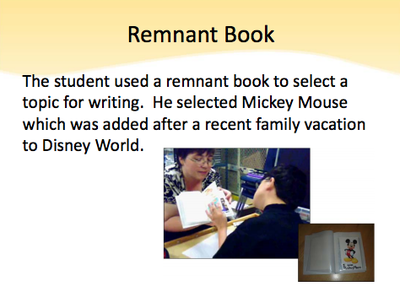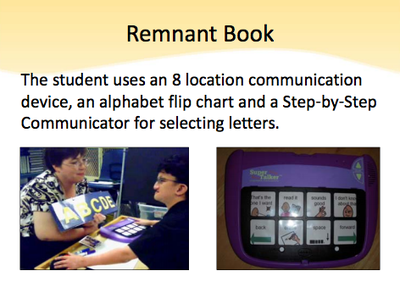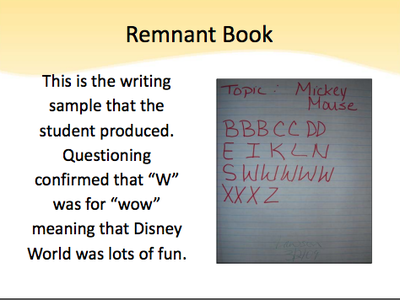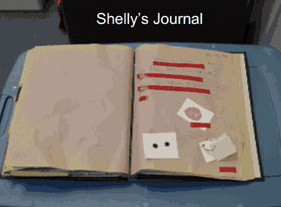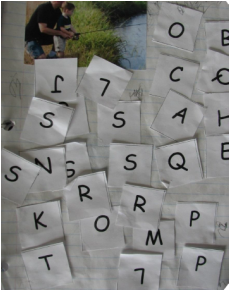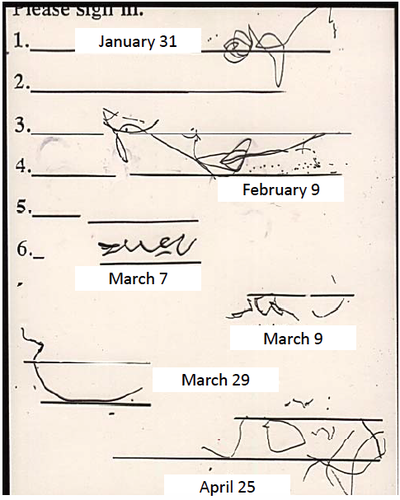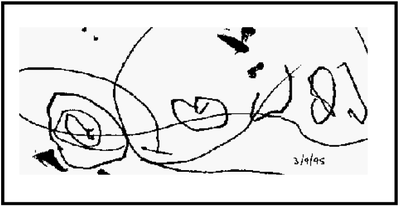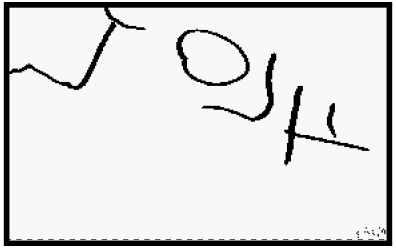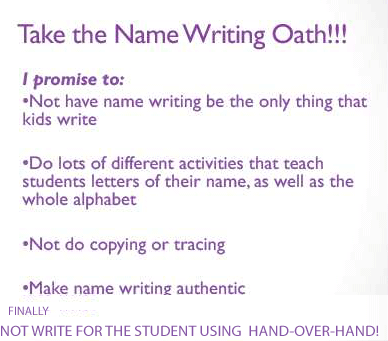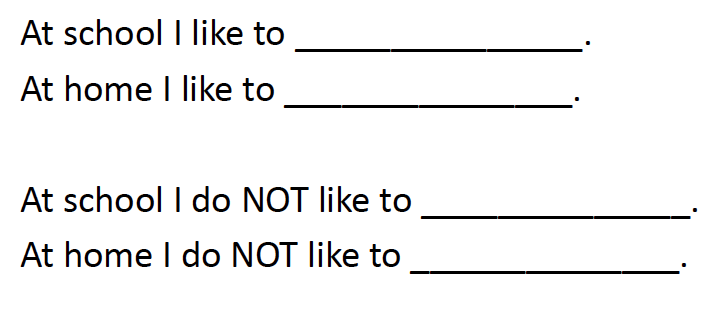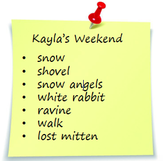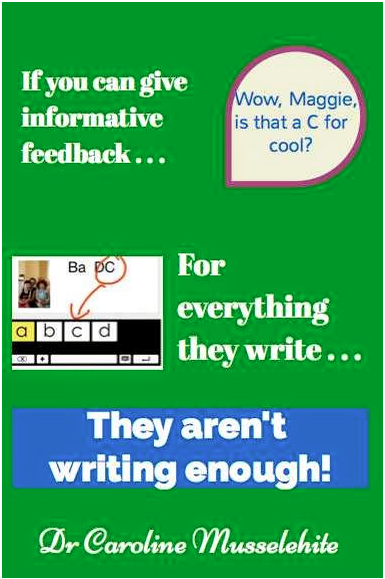A "How to" for writing without standards by Erin Sheldon
Erin Sheldon graciously shares many resources, ideas and research for supporting literacy, communication and inclusion. Please see Angelman.org for some wonderful (free) webinars created with Maureen Nevers and Caroline Musselwhite. Below please Erin's "How to" for writing without standards.
Your browser does not support viewing this document. Click here to download the document.
| a_how_to_for_writing_without_standards_2nd_version.pdf | |
| File Size: | 692 kb |
| File Type: | |
Meaningful Writing Activities for Emergent Writers
Every Day/Every Student created by Caroline Musselwhite is a great way to look at literacy programming as a whole for students with significant disabilities.
Your browser does not support viewing this document. Click here to download the document.
| every_day_chart_final.pdf | |
| File Size: | 65 kb |
| File Type: | |
1. Creating and Using Remnant Books for Self Selected Writing
|
A remnant book is like a scrapbook or visual diary. A small file or mini photo album will serve to hold the entries that represent activities the student has engaged in, things they like, people they know and so on. Entries can include photographs, drawings, menus, ticket stubs, brochures, bus tickets, birthday invitations, magazine cuttings, receipts or packaging. The date and written description can also be added alongside the “remnant”. Remnants can be anything that “tell a story” and should be meaningful to the student.
The document on the right outlines how to create a remnant book and use the remnant book for self selected writing, Beukelman, D. R. & Mirenda, P. (2013). Augmentative & Alternative Communication: Supporting Children & Adults with Complex Communication Needs, 4rd edition. Paul H. Brookes: Baltimore, MD. Musselwhite, C. & Hanser, G. (2003). Write to Talk-Talk to Write!: Supporting Language & Literacy for AAC Users, 2nd edition. Special Communications: Phoenix, AZ
|
Your browser does not support viewing this document. Click here to download the document.
| ||||||
Taken from: Edwards, S., & Stapler, K., (2012). Alternative Pencils http://4waystoliteracy.weebly.com/uploads/2/0/2/8/20288297/r3_alternate_pencil_for_fhf.pdf
2. Alphabet Scavenger Hunt
Student picks a letter and then the partner must find something in the room that begins with that letter. Write down the things that are found, talk about them. Could also be a small group activity with students who are ambulatory.
3. Words About Things I Know
Student picks a letter and then together you make a list of words that begin with that letter. The words must be related to things the student knows. Write them down and talk about them. It can be highly motivating to focus on actions, pictures (of people) or foods that the student is familiar with. Great focus for an individual letter/object book.
4. Tongue Twisters
Student picks a letter and then the writing partner makes up a short tongue twister using that letter. Write it down and talk about it. These can also be typed into document for the student to reread later. There are many apps and web based tools that will allow a student to listen/share their writing.
5. Wheel of Fortune/Hangman
The writing partner thinks of a short word or phrase that the student is familiar with draw the lines for the letters. Give the student the category of the word- person, place or thing. As the student picks letters, write them down either on the line provided in the case of a correct guess or some where else visible to the student in the case of an incorrect guess. Record a game show buzzer on single message device for fun. This could be done on the SmartBoard as a small group activity as well.
6. Write Picture Captions
Have pictures for the student to choose from- could use pictures in their remnant book or a family photo album, magazine or wordless picture book as well. The student chooses on picture to write about. Remember, the student is writing without standards so don't expect or prompt a student to write complete sentences or whole words. Students who are emergent writers will select random letters that will be a challenge to connect to the photo but be creative! This authentic writing activity create opportunities for students to write about what they know.
7. Start a Journal
|
Typically developing students often have the opportunity to write a journal by drawing a picture and then writing about it. For students with significant disabilities, finding a meaningful picture to write about will require getting them started with an alternative pencil and building up a booklet of personally meaningful images. Having family member take photos and share them will be a priority for this type of writing activity as well as taking many photos in class.
|
8. Sign Name for Real Purposes
Have students sign their name for real purposes- art work, signing in when they come to school and out when they leave, signing reminder notes that go home to parents or caregivers, special occasion cards, thank you notes and so on. Record exactly the letters they choose using their alternative pencil. DO NOT provide a model to copy while they are writing their name but DO model it for them after. "You wrote your name! This is how I would write it."
|
Your browser does not support viewing this document. Click here to download the document.
| |||||||
9) Picture Prompts
Nothing fancy here- students choose a picture to write about.
10) Language Experience Charts
11) Sentence Frames
12) Favorites List
Give Me 5
- Books you like to read
- Foods you like to eat
- Things you like to do
13) Rewriting Predictable Story Patterns
Look for story models with rhyme, rhythm, repetition, predictability. Think "Brown Bear" by Eric Carle.
14) Weekend Words
15) Stealing Letters
"Donovan and Dad give thanks."
- Student uses their remnant book to pick a topic, Thanksgiving for instance.
- Students writes freely: DKADGXSPI
- Adult gives instructional feedback
"Donovan and Dad give thanks."
- Adult models writing the word with the student's pencil.
- This strategy can be used with students who are very new to the process as well. For instance if a student is not yet using a remnant book and is just learning how to use her pencil, the same letter stealing process can apply. The adult must find a way to connect a letter the student has chosen to the something meaningful in the student's environment- another student's name, a game or book she enjoys, a character she appreciates or the like.
16) Read it Back
Program a Big Mack or Step-By-Step device with the student's letter or message and allow the student to read her messsage to several people across the day. They could also read it to other students to encourage peer to peer communication.
17) Give Feedback
|
From AAC Girls: Retrived from http://aacgirls.blogspot.ca/2014/10/writing-feedback-quote.html March 2015.
|
|
18. Give Video Feedback
At ATIA 2015, Caroline Musslewhite and Gretchen Hanser demonstrated how to give video feedback using an iPad and a whiteboard app like Explain Everything or ShowMe. Take a picture of the students' writing, upload it to the app, record your feedback while underlining or circling the writing you are highlighting. Students can watch the video clip as many times as they choose!
19. Play Hangman (From Caroline Musselwhite)
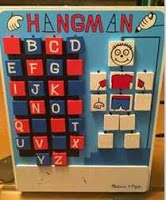
Hangman is great for helping students have FUN with the alphabet. They can explore the alphabet and learn about letters, and where they go in building words. Most importantly, this is an INTERACTIVE way to engage in alphabet exploration!
Hangman can be played using the student’s alphabet, whether light tech or high tech. Whatever system the child is using is great. For example:
Hangman can be played using the student’s alphabet, whether light tech or high tech. Whatever system the child is using is great. For example:
- Jen uses an alphabet flipbook. When she plays Hangman with her brother, she pics a letter, any letter. He then puts it into the Hangman game and together, they cheer . . . or groan. Her brother makes sure to name the letter that she picks, both from her system, and when he puts it into the game.
- Jesus uses the alphabet page on his iPad AAC app. He plays Hangman with his Communication Circle. When he picks a letter, one of his friends calls out the letter, then uses the Hangman app and types the letter in, naming it again. The app they use is described in the Spedapps2 wiki:
- Marcus plays hangman using the Melissa & Doug Travel Hangman set. He plays with his Dad, and it’s big fun for both of them! Every time Marcus picks a letter (using the alphabet page on his PODD), his Dad calls out the letter, then puts it into the Hangman set, calling it out again. Marcus’s brother sometimes whispers clues to him, and Marcus is becoming adept at finding letters his brother suggests.
References:
Edwards, S., & Stapler, K., (2012). Alternative Pencils. Retrieved December 2014, from http://4waystoliteracy.weebly.com/uploads/2/0/2/8/20288297/r3_alternate_pencil_for_fhf.pdf
Erickson, K. & Koppenhaver, D. (2007). Children with Disabilities: Reading and Writing the Four Blocks® Way, Greensboro, NC: Carson-Dellosa.
Hanser, G. (2009). Write from the start. . .with an "alternative pencil. " Developed by The Center for Literacy and Disability Studies. Retrieved from http://www.med.unc.edu/ahs/clds/products/available-for-purchase.
Hanser, G. (2014). Literacy in Angelman Syndrome Workshop. Retrieved March 2015, from https://www.youtube.com/watch?v=X2nkRllUw1U
Louisiana Department of Education. Alternate Pencils. Access Guide: Students with Significant Disabilities. Retrieved December 2014, from http://sda.doe.louisiana.gov/Site%20Pages/LiteracyView.aspx
MusselWhite, C. AAC Girls. Retrieved December 2015, from http://aacgirls.blogspot.ca/
Sign In/Sign up/Sign off. Retrieved March 2015, from http://aacintervention.com/home/180009852/180009852/Tips/2014/01Jan2014/Sign%20In%20Up%20Off%20Intro.pdf
